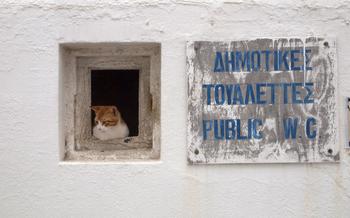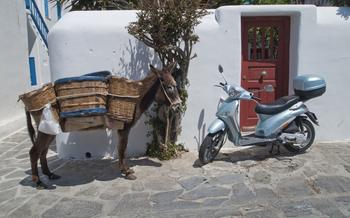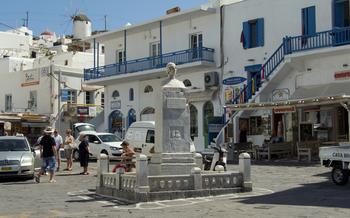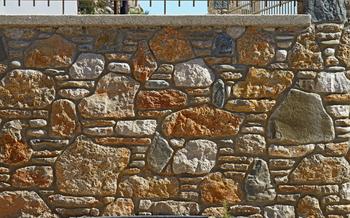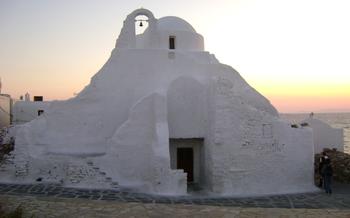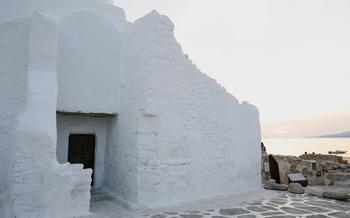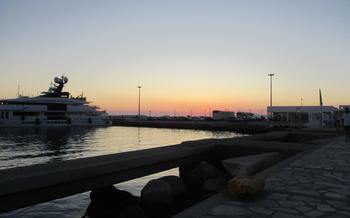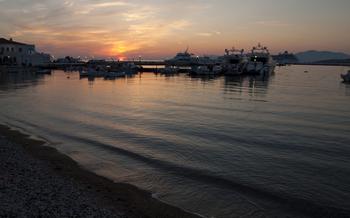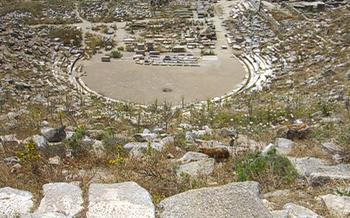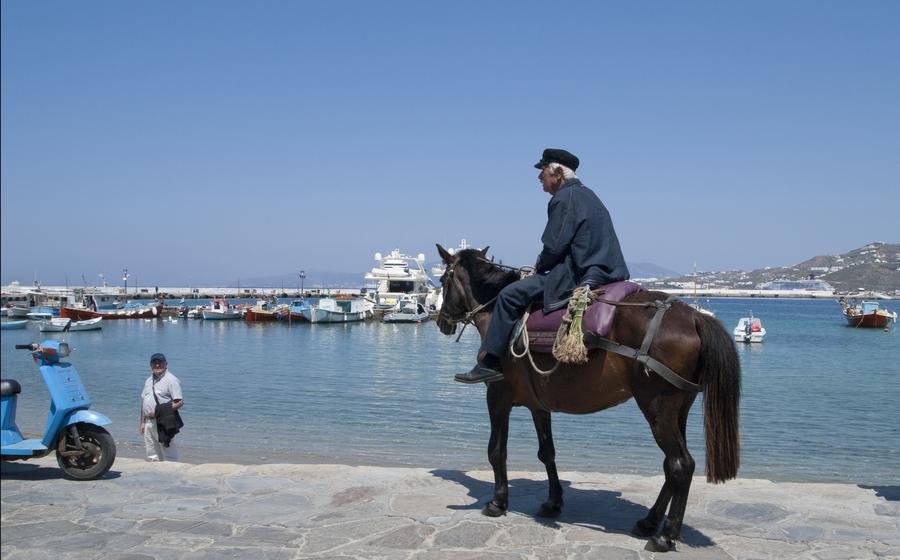
Paleokastro Monastery
- Historical Significance
- Location and Accessibility:
- Architectural Features
- Religious Significance
- Museum and Artifacts
- Panoramic Views
- Peaceful Atmosphere
- Guided Tours
- Souvenir Shop:
- Dress Code and Etiquette
- Photography and Videography
- Accessibility for Visitors with Disabilities
- Local Tips and Recommendations
- Insider Tip: Venture beyond the main courtyard of the monastery to discover a hidden gem – a secluded chapel nestled amidst the surrounding hills. This lesser-known chapel offers breathtaking panoramic views of the Aegean Sea and the neighboring islands. Capture the essence of this tranquil sanctuary as you immerse yourself in its serene atmosphere, away from the crowds. For the ultimate photography experience, visit during the golden hour just before sunset, when the warm hues of the sky bathe the chapel in a magical glow.
Historical Significance
The Paleokastro Monastery, nestled on a hilltop overlooking the azure waters of the Aegean Sea, holds a profound historical and religious significance in Mykonos. Founded in the 18th century, the monastery stands as a testament to the island's rich cultural heritage. Visitors to this ancient sanctuary can embark on a journey through time, delving into the monastery's captivating history.
Legends and stories abound, weaving a rich tapestry of tales surrounding the monastery's origins. Some say it was built on the site of an ancient temple dedicated to the Greek goddess Artemis, adding an air of mystique to its sacred grounds. Over the centuries, the monastery has borne witness to Mykonos's transformation from a humble fishing village to a bustling tourist destination. Its enduring presence serves as a reminder of the island's deep-rooted traditions and spiritual essence.
Architecturally, the Paleokastro Monastery showcases a harmonious blend of Byzantine and Venetian influences, reflecting the diverse cultural currents that have shaped Mykonos. Its exterior exudes a sense of solidity and grandeur, with thick stone walls and arched entrances hinting at the sanctuary within. Inside, visitors are greeted by a serene atmosphere, adorned with intricate frescoes, a majestic iconostasis, and vaulted ceilings that speak to the skill and devotion of its builders.
Location and Accessibility:
To reach the Paleokastro Monastery from Mykonos Town, you can take a scenic 10-minute drive following the winding roads that lead to Ano Mera, a traditional village nestled in the heart of the island. The monastery is situated on a hilltop overlooking the village, offering breathtaking views of the Aegean Sea and the surrounding countryside.
For those who prefer public transportation, there are regular buses that depart from Mykonos Town to Ano Mera. From the bus stop, it's a short and pleasant walk uphill to the monastery, allowing you to soak in the tranquility of the surroundings.
If you're looking for a more personalized experience, consider renting a vehicle to explore the island at your own pace. This option offers the flexibility to visit the monastery at your convenience and allows you to discover other hidden gems along the way.
Once you arrive at the monastery, you'll find ample parking space for both cars and tour buses. From the parking area, it's just a short walk to the entrance of the monastery, where you'll be greeted by the serene atmosphere and stunning views that await you.
Architectural Features
The Paleokastro Monastery stands as a testament to the fusion of Byzantine and Venetian architectural styles. Its exterior exudes a sense of grandeur, with a bell tower that pierces the sky and an arched entrance that invites visitors into its sacred space. The interior of the monastery is adorned with intricate frescoes, depicting biblical scenes and the lives of saints. The iconostasis, a beautifully carved wooden screen that separates the sanctuary from the nave, is a masterpiece of craftsmanship. Vaulted ceilings add to the monastery's spacious and awe-inspiring atmosphere, creating a sense of reverence and tranquility.
Religious Significance
The Paleokastro Monastery holds immense religious significance as a center of Orthodox Christianity in Mykonos. It serves as a spiritual haven for the local community and attracts pilgrims and visitors from around the world. The monastery's sacred atmosphere and rich history contribute to its status as a revered religious institution.
The monks residing in the monastery play a vital role in the spiritual life of the community. They dedicate their lives to prayer, contemplation, and the preservation of Orthodox traditions. Visitors can witness the monks' devotion during daily services and religious ceremonies, which are open to the public.
The monastery's festivals, particularly the feast day of Saint Nicholas, draw large crowds of worshippers. During these celebrations, the monastery transforms into a vibrant center of religious fervor, with processions, chanting, and communal prayers.
Beyond its spiritual significance, the monastery also contributes to the preservation of Orthodox heritage and culture. It houses a valuable collection of religious artifacts, icons, and manuscripts that offer a glimpse into the history and traditions of the Orthodox Church. The monastery's commitment to preserving these treasures ensures that future generations can continue to learn about and appreciate the Orthodox faith.
Museum and Artifacts
Within the confines of the Paleokastro Monastery complex lies a treasure trove of religious artifacts, historical documents, and captivating icons. The monastery's museum serves as a repository for these invaluable relics, offering visitors a glimpse into the rich tapestry of the monastery's past.
Among the museum's highlights is an exquisite collection of Byzantine icons, each a testament to the skill and devotion of the artisans who created them. These sacred images, adorned with gold leaf and vibrant colors, depict scenes from the life of Christ, the Virgin Mary, and various saints. Their intricate details and expressive faces invite visitors to contemplate the spiritual significance of these works of art.
In addition to the icons, the museum houses a collection of historical documents that shed light on the monastery's founding, its role in the community, and its interactions with the outside world. These documents, ranging from ancient manuscripts to papal bulls, provide valuable insights into the monastery's evolution over the centuries.
One of the most remarkable artifacts in the museum is a beautifully preserved 16th-century Gospel book. Its pages are adorned with intricate calligraphy and illuminated with gold leaf, showcasing the meticulous craftsmanship of the monks who created it. This Gospel book serves as a testament to the monastery's commitment to preserving and transmitting religious knowledge.
Through its collection of artifacts, the Paleokastro Monastery Museum offers visitors a unique opportunity to delve into the rich history and spiritual heritage of this sacred site. Each piece in the collection tells a story, inviting visitors to connect with the past and gain a deeper understanding of the monastery's enduring significance.
Panoramic Views
The Paleokastro Monastery offers breathtaking panoramic views of the Aegean Sea, the surrounding islands, and the stunning Mykonos coastline. The elevated location of the monastery provides visitors with an unparalleled perspective, allowing them to capture breathtaking sunsets and sweeping vistas. The monastery's outdoor terraces and courtyards serve as ideal spots to soak in the beauty of the natural surroundings. Whether you're an avid photographer looking to capture stunning images or simply seeking a moment of tranquility amidst the picturesque scenery, the panoramic views from the Paleokastro Monastery are not to be missed. Remember to bring your camera to capture the magical moments, especially during the golden hour when the sky transforms into a canvas of vibrant colors.
Peaceful Atmosphere
The Paleokastro Monastery offers a sanctuary of peace and tranquility amidst the bustling tourist crowds of Mykonos. Step inside the monastery grounds, and you'll be enveloped by a serene and spiritual atmosphere. The tranquil ambiance invites you to slow down, find moments of reflection, and connect with your inner self. As you wander through the monastery's courtyards, the sound of your footsteps and the gentle breeze rustling through the trees create a symphony of calm. Take a seat on one of the stone benches beneath the shade of a cypress tree and let the tranquility wash over you. Close your eyes and listen to the silence, broken only by the distant sound of church bells or the melodious chanting of the monks. The Paleokastro Monastery is a sacred space where you can escape the distractions of modern life and find solace and peace amidst the beauty of nature and spirituality.
Guided Tours
The Paleokastro Monastery offers guided tours that provide visitors with a deeper understanding of its history, architecture, and religious significance. These tours are led by knowledgeable guides who share fascinating insights and anecdotes about the monastery's past and present. The tours are available in multiple languages, ensuring that visitors from all over the world can learn about this iconic landmark. It's highly recommended to book a tour in advance to avoid disappointment, especially during the peak tourist season. Booking a guided tour is an excellent way to make the most of your visit to the Paleokastro Monastery and gain a comprehensive understanding of its rich history, cultural significance, and architectural beauty.
Souvenir Shop:
Within the monastery complex, there is a modest yet charming souvenir shop that offers a variety of items for purchase. Visitors can find an array of religious icons, each intricately crafted and depicting various saints and scenes from the Bible. These icons serve as a tangible reminder of the monastery's deep religious heritage and can be a meaningful keepsake for visitors.
The shop also offers an assortment of postcards featuring breathtaking views of the monastery and the surrounding landscape. These postcards are a fantastic way to share the beauty of Mykonos with friends and family back home.
Furthermore, visitors can purchase handmade crafts created by local artisans. These unique items, often adorned with traditional Greek motifs, showcase the creativity and skill of the island's talented craftsmen.
By purchasing a souvenir from the monastery's shop, visitors not only take home a memento of their visit but also contribute to the preservation and upkeep of this historic and sacred site.
Dress Code and Etiquette
When visiting the Paleokastro Monastery, it is important to be mindful of the religious nature of the site. Visitors should dress modestly, with shoulders covered and shorts or skirts that reach below the knee. Revealing or beachwear is not appropriate. It is also essential to be respectful and mindful of the monks and other visitors. Silence should be observed within the monastery grounds, and visitors should avoid disturbing the monks in their prayers or daily activities. Photography and videography are permitted, but visitors should be discreet and avoid taking pictures of people without their permission. By following these guidelines, visitors can show respect for the sacred space of the monastery and contribute to a peaceful and contemplative atmosphere.
Photography and Videography
Respecting the sacred nature of the monastery, visitors are kindly requested to adhere to the photography and videography guidelines. While capturing the beauty of the monastery through your lens is encouraged, it is important to be mindful of the privacy of the monks and other visitors. Refrain from using flash photography or videography equipment that may disrupt the serene atmosphere. Before taking photographs or videos of individuals, it is considered polite to ask for their permission. By following these guidelines, you can ensure that your visit to the Paleokastro Monastery is both enjoyable and respectful.
Accessibility for Visitors with Disabilities
The Paleokastro Monastery is committed to ensuring that all visitors have a welcoming and accessible experience. While the monastery's historic nature presents some challenges, efforts have been made to accommodate visitors with disabilities. The main entrance to the monastery is wheelchair accessible, and there are ramps and handrails throughout the complex to assist with navigation. Visitors with mobility challenges may find some areas of the monastery, such as the narrow staircases leading to the upper levels, to be difficult to access. However, the ground floor of the monastery, which includes the main church, the museum, and the courtyard, is fully accessible. Visitors with specific accessibility needs are encouraged to contact the monastery in advance to inquire about any additional assistance or accommodations that may be available. The monks are dedicated to providing a welcoming and inclusive environment for all visitors, regardless of their abilities.
Local Tips and Recommendations
To make the most of your visit to the Paleokastro Monastery, consider combining it with other nearby attractions. The Mykonos Windmills, with their iconic whitewashed sails, are just a short distance away and offer stunning views of the island. Another must-see is the Little Venice district, with its charming canals and colorful buildings. Several local restaurants and cafes in the area serve traditional Greek cuisine, providing a delightful culinary experience.
For a more tranquil experience, visit the monastery during the off-season, typically from November to March. During this time, you'll encounter fewer crowds and have more opportunities to appreciate the monastery's serene atmosphere. The mild weather also makes it an ideal time for exploring the surrounding landscape and enjoying the island's many hiking trails.
